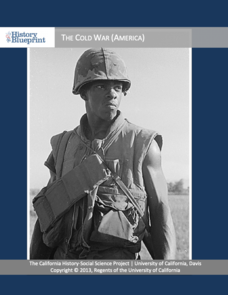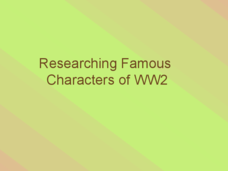Carolina K-12
The Major Conferences of World War II
Young historians create a 1940's news radio broadcast on the five major World War II conferences, including the Atlantic, Casablanca, Tehran, Yalta, and Potsdam.
University of California
Roots of the Cold War
When and how did the Cold War begin? To answer this question, you will not find a better-organized, in-depth, activity- and inquiry-based resource than this! Executing best teaching practices throughout, each portion of this inquiry...
Utah Education Network (UEN)
Classical Appeals and War Speeches
Discuss classical appeals of rhetoric through the speeches of Winston Churchill and FDR. Learners read, annotate, and analyze the speeches by the men before using a graphic organizer to track the use of ethos, pathos, and logos.
University of California
The Cold War (America)
The Cold War—with its roots in World War II—impacts the world today. Using an extensive curriculum, scholars consider its impact through primary sources, including speeches and propaganda, as well as other skills-enhancing activities. An...
US National Archives
Eastern Europe 1939-45 — Camps
Britain's decision not to bomb German death camps in World War II has provided many questions for historians, but with a primary source analysis lesson, high school students may be a step closer to finding out the truth. Learners read...
US National Archives
WWII: Western Europe 1939-45 – End of the War
You are Winston Churchill, and on May 9th, 1945, you receive millions of grateful cards and telegrams. How do you respond? High schoolers put themselves in the Prime Minister's chair with an activity that prompts them to respond to a...
US National Archives
WWII: Western Europe 1939-45 – Deception and Bluff
World War II left the British desperate for help in any form—including in the form of a magician! High schooler conduct research on Jasper Maskelyne, a stage magician who used his talents to deceive the Germans on the war front, before...
US National Archives
WWII: Western Europe 1939-45 – Resistance and SOE
Germany seemed to be unstoppable in the early years of World War II, but the tireless and sacrificial work of the Special Operations Executive (SOE) helped to steer the war in another direction. After exploring primary source documents,...
BAE Systems
The Cold War
The Soviet Union's decision to block West Berlin from access by the Western allies began an international hostility that extended into the rest of the twentieth century. Class members examine both Harry Truman's and Joseph Stalin's...
Constitutional Rights Foundation
The Cold War: How Did It Start? How Did It End?
What is the difference between a Cold War and a Hot War? Scholars research the beginning of the Cold War. They analyze diary entries as well as excerpts from various events during the 45-year standoff. To finish, they prepare final...
National Endowment for the Humanities
How "Grand" and "Allied" Was the Grand Alliance?
Learn more about the Grand Alliance with a scaffolded lesson plan that includes four activities. Class members use primary sources to complete a map exercise, understand the goals and objectives of each individual nation, and participate...
K12 Reader
Churchill's Speech: We Shall Fight on the Beaches
Winston Churchill speech delivered to the House of Commons on June 4, 1940, is the focus of a comprehension exercise that asks readers to explain how the repetition in the speech supports the main purpose of Churchill's address.
Curated OER
Researching Famous Characters of WWII
In collaborative groups, learners will research one of the three famous characters outlined in this presentation. The resource introduces Adolf Hitler, The Royal Family, and Winston Churchill, then asks each group to research and prepare...
Curated OER
Writing Exercises: World War II, #1
Has your class just finished reading about WWII and you need a way to let them show what they know? Hand them this three-question writing prompt. They'll need to describe the role Winston Churchill played in the war, the Rape of Nanking,...
Curated OER
Children and World War II
Intended for a younger audience, this presentation provides a very simplistic overview of the people and events key to World War II. They will be introduces to Hitler, Chamberlain, and Churchill, hear an audio piece, and see images from...
Curated OER
Hitler's Lightning War
When you line them up, you can knock them down. Hitler had a plan, carried it out, and started WWII. This presentation focuses on Hitler's military and political tactics, who he fought, and how his opponents fell. Key players and events...
Curated OER
Winston Churchill
In this World War II worksheet, students read a 3-paragraph selection about Winston Churchill and then respond to 5 short answer questions based on the selection.
Curated OER
The Munich Conference
For this World War II worksheet, students read a 1-page selection about the Munich Conference, examine a chart about the Axis and Allied powers, and then respond to 3 short answer questions about the information presented.
Curated OER
Primary Source: Churchill Speaks to the British People
In this World War II instructional activity, students read an excerpt of a speech from Winston Churchill to the British people. Students then respond to 5 short answer questions based on the speech.
National Archives (UK)
The Learning Curve: Allies at War
An extensive site chronicling the public consensus shown to the media among Allied members: the USSR, Great Britain, and the USA. Gives ample primary sources and student activities.
ibiblio
Ibiblio: Churchill's Broadcast About Roosevelt
Transcript from Churchill's radio broadcast to the world regarding his meetings with Roosevelt at the Atlantic Conference in 1941. From the British Library of Information.
Digital History
Digital History: Munich: Anatomy of a Crisis [Pdf]
This excellent lesson plan lays out the framework of the lead-up to World War II in Europe. It covers the problem the support of Czechoslovakia caused Great Britain and France, the policy of appeasement exercised by Prime Minister...
US Navy
Naval Historical Center: The Potsdam Conference, July August 1945
This is a brief summary with pictures of the Potsdam Conference.
US Army Center
U.s. Army Center of Military History: Peace Becomes Cold War, 1945 1950
A discussion of historical events that led to the Cold War from the perspective of the U.S. Army. Particular emphasis is placed on military leadership and policy.























![Digital History: Munich: Anatomy of a Crisis [Pdf] Website Digital History: Munich: Anatomy of a Crisis [Pdf] Website](https://d15y2dacu3jp90.cloudfront.net/images/attachment_defaults/resource/large/FPO-knovation.png)
